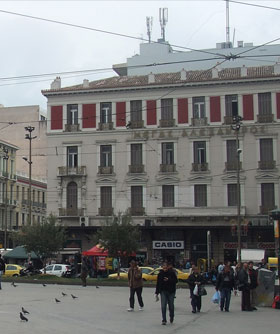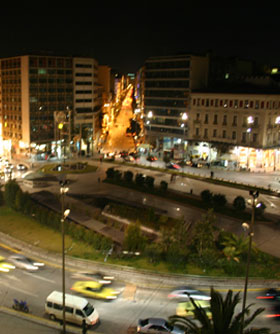

Athens Omonia Square
In the aftermath of the decision to make Athens the capital of the new monarchy in 1833 came the task of designing a city plan which would incorporate the new political institution and the anticipated increase in population. The old Byzantine/Ottoman city within the Late Roman Fortification wall on the northern slopes of the Acropolis was not a suitable place to start. Rather, the rural land to the north and east were chosen for development. In 1834 Leo von Klenze (1784-1864), the architect of the Bavarian King Ludwig I (the father of Greece's first king Othon), executed a plan based on the ideas which Stamatis Kleanthis and Edouard Schaubert formulated in 183 1-1832. Originally the Palace was intended to be built where this square is now located. Hence, the name of the space was Palace Square. The next location chosen for the Palace was in the area of Kerameikos, which was quickly discovered to be a large ancient cemetery. The palace ended up in it present position, now the House of Parliament, facing Syntagma Square. Starting in 1834, Omonia square was laid out along with many of the other elements of the plan. The original intention was for the circular Omonia Square to be balanced by a similar circular one where Syntagma Square is today.
The other name for the square was Othonos Square, after the first king. After Othon and Amalia were forced to abdicate, due to popular discontent and an uprising, this name was abandoned. In October 1862, the name was changed by Admiral Constantinos Kanaris, the Prime Minister, to Omonia Square, to mark the occasion of (momentary) national unity and resolve. It has retained this name ever since and this designation has grown to refer to the mostly commercial and touristic district around it.
With the addition of a major station on the Piraeus - Kifissia railway line at the end of the 19th century, Omonia Square became a major center of Athenian life and a rival of Syntagma Square. During the Belle Epoque and early 20th century, numerous hotels were built around it. These included the Excelsior (still standing on the corner of Panepistimiou str., with an attractively restored facade for use by the National Bank of Greece), the Plaza, the Bangeion (still standing, designed in 1890 by Ernst Ziller and restored for use by Mediterranean ECS with shops below, on the corner of Athinas str.) and the Alexander the Great (Megas Alexandros, designed in 1889 also by Ziller and still standing, and restored, on the other corner of Athinas str.).
Omonia Square and its environs became an ideal place for coffeehouses, such as the Soloneion, Zavoritis and Zounis. After the end of the Civil War in 1949 the area began to decline slowly, despite the fact that it was a popular place for men to gather in small groups to argue about politics and sports. By the early 1990s it was tawdry and run-down. At night, this general area is a dangerous place with drug deals and use as well as the crimes that coincide with such activities occurring regularly, alas. Urban renewal, new businesses, renovation of the remaining Neoclassical buildings, the new Metro station and the redesign of the square in order to restrict the incessant, traffic flow around it, give hope to saving this major square for the enjoyment of more people.
The lack of plantings, benches etc, makes this, however, a singularly most unattractive place and not conducive for lingering or contemplation of the surrounding cityscape.
